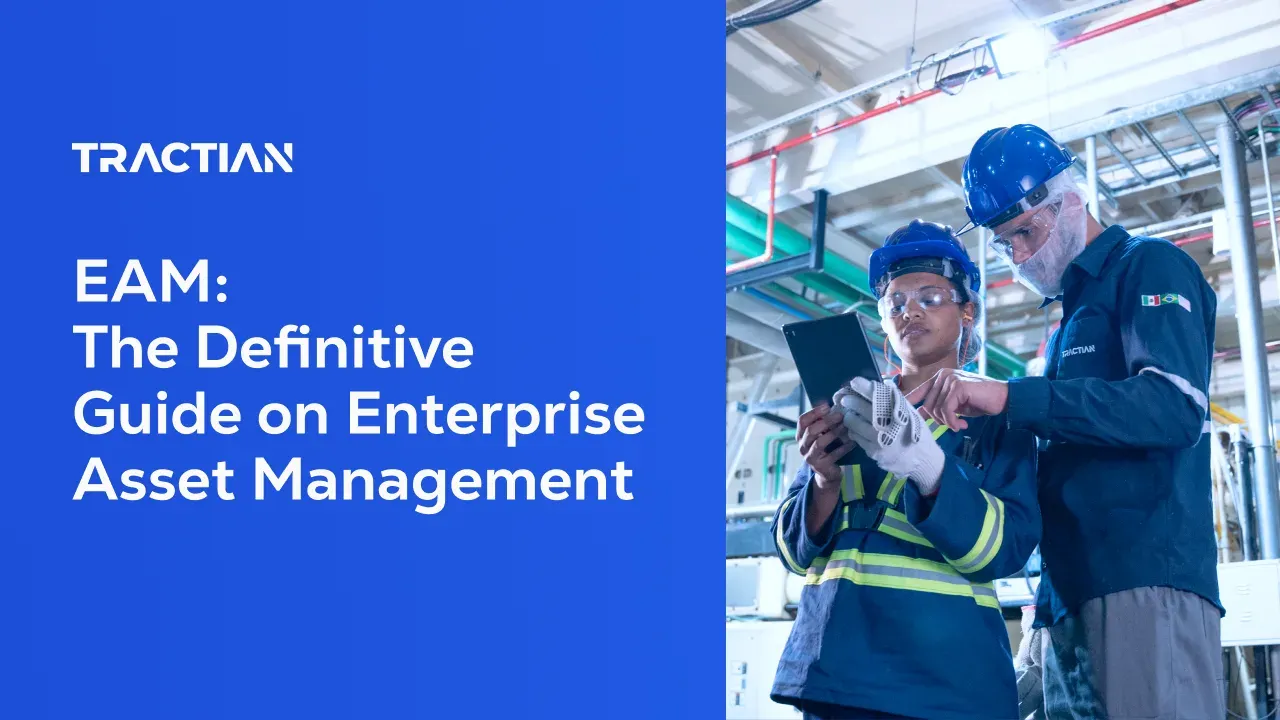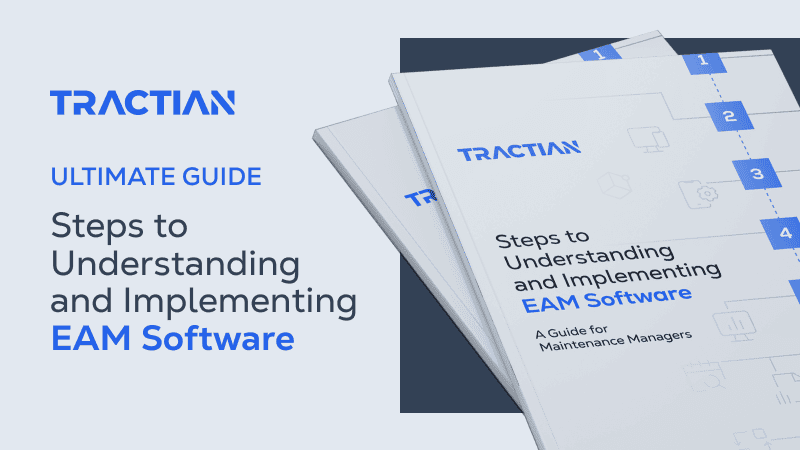Enterprise Asset Management (EAM) It’s more than just keeping track of your stuff, it’s a strategic approach that optimizes how you use your equipment.
Think of it as the conductor of your entire operation, making sure everything runs smoothly and efficiently.
EAM has come a long way. It used to be all about spreadsheets and filing cabinets, but now it’s a sophisticated system that integrates with your whole business.
It helps you predict maintenance needs, schedule repairs strategically, and even track the performance of your assets
Intrigued? This article is your one-stop shop for everything EAM. We’ll break down the complex stuff into clear, bite-sized pieces, using real-world examples to show you how EAM can transform your business.
Get ready to discover how EAM can unlock:
- Boosted asset utilization: Get the most out of your equipment, maximizing its lifespan and productivity.
- Enhanced operational efficiency: Streamline your maintenance processes and minimize downtime.
- Reduced costs: Save money by preventing breakdowns and optimizing resource allocation.
- A competitive edge: Stay ahead of the curve with a proactive approach to asset management.

Ready to dive deeper? Let’s go!
What is Enterprise Asset Management (EAM)?
Think of your organization’s assets - the buildings, machinery, vehicles, and technology that keep things running. Enterprise Asset Management is like a special organizer for all these essentials.
This system goes beyond traditional asset management.
In the past, keeping tabs on assets might have involved spreadsheets or clunky databases. EAM takes things to the next level.
It integrates seamlessly with other business systems, giving you a holistic view of your assets and how they impact your bottom line.
Here’s the key difference:
Traditional asset management focuses on reactive maintenance - fixing things when they break. EAM, on the other hand, is proactive. It helps you predict and prevent problems before they occur, saving you time, money, and headaches.
The Evolution of EAM
Remember the days of managing assets with clipboards and scribbled notes? Believe it or not, that’s where Enterprise Asset Management began.
Early asset management was a manual affair, relying on spreadsheets and ledgers to track things like maintenance schedules and equipment inventory.
It was cumbersome and prone to errors.
The Rise of the Machines (and Software!)
Thankfully, technology marched on.
The introduction of computerized maintenance management systems (CMMS) ushered in a new era. These early EAM systems offered a more efficient way to track and manage assets.
They streamlined tasks like work order creation, preventive maintenance scheduling, and inventory control.
We’ve analyzed the differences between EAM and CMMS in an article. Go check it out!
The Age of Integration and Beyond
But EAM didn’t stop there.
As technology continued to evolve, EAM systems became even more sophisticated.
They started integrating with other business systems like accounting and procurement, providing a more comprehensive view of an organization’s assets. They also became mobile, allowing for a more precise management.
This holistic approach allowed for better decision-making and improved asset utilization.
Enter the Powerhouse: IoT and AI
The arrival of the Internet of Things and Artificial Intelligence marked a turning point in EAM’s evolution - specially with the fourth revolution, Industry 4.0, happening.
IoT sensors embedded in equipment can now collect real-time data on performance and health.
And AI utilizes this data to predict potential problems before they occur, allowing for AI-assisted proactive maintenance and minimizing downtime.
These advancements transformed EAM from a simple record-keeping tool into a dynamic system that drives strategic decision-making and optimizes asset performance.
EAM vs. ERP: Understanding the Differences
Enterprise Asset Management and Enterprise Resource Planning (ERP) systems might sound similar, but they serve distinct purposes.
Here’s how to tell them apart:
EAM: The Asset Engineer
Imagine EAM as the pit crew in a Formula 1 race.
Their focus is laser-sharp - keeping your physical assets, like machinery and equipment, in top shape.
EAM helps you track maintenance schedules, predict potential problems, and optimize asset performance throughout their lifecycle.
Think of it as maximizing the return on investment for all your physical equipment.
ERP: The Business Conductor
ERP, on the other hand, takes a broader view. It’s like the conductor of an orchestra, coordinating all the different sections of your business.
ERP systems manage functions like finance, human resources, supply chain management, and production planning. They ensure all these departments are working together seamlessly towards a common goal.
But… How can both systems work together? Let’s take a look at a real-world example:
Imagine a manufacturing plant.
The EAM system is constantly monitoring the health of equipment. It detects a potential issue with a critical machine and triggers a work order for maintenance.
Meanwhile, the ERP system, aware of upcoming production schedules that rely on this machine, can automatically adjust production plans or reroute materials to minimize downtime.
This teamwork between EAM and ERP ensures:
- Improved Overall Equipment Effectiveness (OEE): With EAM keeping machines running smoothly, production can hit peak efficiency.
- Streamlined Operations: Data flows seamlessly between departments, reducing errors and inefficiencies.
- Reduced Costs: Proactive maintenance through EAM prevents costly breakdowns, while ERP optimizes resource allocation.
Key Features of an Effective EAM System
An effective EAM system is like a well-oiled machine, packed with features to optimize your assets. Here are some essentials:
- Asset Lifecycle Management: Track your assets from acquisition to disposal, maximizing availability, performance and value throughout their lifespan.
- Work Order Management: Streamline maintenance tasks, ensuring timely repairs and minimizing downtime. Imagine a maestro conducting an orchestra of technicians and resources.
- Predictive Maintenance: Leverage data and IoT to predict equipment failures before they happen. Think crystal ball for your assets, enabling proactive maintenance and smooth operations.
- Inventory & Spare Parts Management: Maintain optimal inventory levels, ensuring the right parts are on hand while preventing overstocking. No more scrambling for missing wrenches!
- Reporting & Analytics: Gain valuable insights into asset performance, maintenance history, and costs. Make data-driven decisions to optimize maintenance and maximize return on investment.
The Role of EAM in Modern Businesses
If you work on an industrial environment, you already know: optimizing asset performance it’s a necessity.
Here’s where Enterprise Asset Management steps in as a strategic powerhouse. But how? We can explain:
Make Smarter Decisions
Data is king, and EAM provides a wealth of insights into your assets.
With robust reporting and analytics, you can identify trends, predict potential problems, and make data-driven decisions about everything from maintenance schedules to resource allocation.
Slash Costs
The numbers speak for themselves. The EAM market is booming, projected to reach USD 7.6 billion by 2028, with a growth rate of nearly 10%. This surge reflects the significant cost savings EAM delivers.
Think about it: a staggering 80% of businesses are stuck reacting to maintenance issues instead of preventing them. EAM flips the script, enabling proactive maintenance that minimizes costly breakdowns and extends asset lifespans.
But the benefits go beyond reduced repair costs.
EAM can also help identify and eliminate “ghost assets” - those unused or underutilized assets that drain budgets.
Studies show that a typical organization harbors 5-10% of these hidden costs. EAM helps you pinpoint these ghosts and free up valuable resources.
Boost Operational Efficiency
Imagine a well-oiled machine - that’s what EAM can do for your operations.
Efficient work order management ensures timely maintenance, minimizing downtime and keeping your production lines humming.
Predictive maintenance takes things a step further, allowing you to anticipate and address potential issues before they disrupt operations. Real-world examples showcase the transformative power of EAM.
Solutions like TRACTIAN’s system have demonstrably reduced downtime by a staggering 43%, slashed scrap costs by 25%, and even lowered preventive maintenance expenses by 30% - you can check more ROI related stuff about TRACTIAN’s solutions here.
These results translate directly into a more efficient, streamlined operation.
Tired of siloed data and reactive maintenance?
TRACTIAN’s TracOS™ goes beyond CMMS, offering a unified EAM/CMMS solution for total asset mastery.
Real-time insights, AI-powered maintenance, and seamless integrations empower you to optimize asset performance, maximize uptime, and rule asset management. Request a free demo today and see the TRACTIAN difference!
How EAM Integrates with Other Business Systems
The good news? Modern EAM systems aren’t islands.
What we mean by that: they integrate seamlessly with other business-critical systems like ERP, CRM, and SCM.
Think of it as creating a synchronized business orchestra, where each system plays its part in perfect harmony.
Here’s the magic of integration:
- Unparalleled Data Accuracy: Imagine siloed data scattered across different systems. Integration creates a single source of truth, eliminating inconsistencies and ensuring everyone is working with the same accurate information.
- Streamlined Processes: Say goodbye to data re-entry and manual workflows. Integration automates data flow between systems, fostering seamless communication and streamlining processes.
- 360-Degree Visibility: EAM’s asset insights combined with ERP’s financial data, CRM’s customer information, and SCM’s supply chain dynamics paint a holistic picture of your business. This empowers you to make well-informed decisions based on a complete view of your operations.
- Enhanced Agility: A unified business ecosystem allows you to adapt quickly to changing market conditions and operational demands. With all your data connected, you can identify trends and opportunities faster, making your business more responsive and competitive.
EAM Implementation Best Practices
A successful EAM implementation requires careful planning and execution. Here are key practices to follow:
- Choose Wisely: Select an EAM system that caters to your specific needs. Consider functionality, scalability, and seamless integration with existing systems.
- Data on Point: Plan data migration meticulously to ensure accurate and complete transfer of information to the new system.
- Empower Your Team: Equip users with the knowledge and skills to navigate the new system through comprehensive training programs.
- Collaboration is Key: Involve all relevant stakeholders throughout the process to align goals and expectations.
- Embrace Change: Address employee concerns about the new system. Clear communication and ongoing support are essential for fostering user acceptance.
By following these best practices, you can ensure a smooth EAM implementation that empowers your team and optimizes asset management for long-term success.
How EAM Ties With Future Trends in Asset Management
Yeah, we know: EAM might seem like a concept “ahead of its time,” but in reality, it’s perfectly positioned to embrace the future of asset management.
Cutting-edge technologies like AI, machine learning, and blockchain are not just buzzwords; they’re powerful tools that will propel EAM into a new era of efficiency and intelligence.
Here’s how:
- AI and Machine Learning: Imagine EAM that’s not just reactive, but truly predictive. AI and machine learning algorithms will analyze vast amounts of asset data, enabling EAM to anticipate potential problems before they occur. This translates to proactive maintenance, minimizing downtime and maximizing asset uptime.
- Blockchain - Transparency by Design: Blockchain technology can revolutionize asset management by introducing unparalleled transparency and security. Imagine a secure, tamper-proof record of an asset’s entire lifecycle, from manufacturing to ownership changes and maintenance history. This empowers EAM systems to track assets with unprecedented accuracy, streamlining transactions and fostering trust within the supply chain.
These advancements highlight how EAM it’s a visionary approach that lays the foundation for future innovations.
Conclusion
This guide has shed light on the transformative power of Enterprise Asset Management (EAM).
We’ve explored its journey from simple asset tracking to a sophisticated, integrated system that optimizes performance and drives strategic decision-making.
The message is clear: EAM is not just a tool; it’s a strategic imperative for businesses seeking operational excellence.
By harnessing EAM’s capabilities, you can:
- Maximize Asset Uptime: Reduce downtime and keep your operations running smoothly.
- Optimize Maintenance Strategies: Shift from reactive repairs to proactive maintenance, extending asset lifespans and minimizing costs.
- Empower Data-Driven Decisions: Gain valuable insights into your assets, allowing you to make informed choices that drive efficiency and profitability.
But EAM’s potential doesn’t stop here.
The future of asset management is brimming with exciting possibilities. Emerging technologies like AI, machine learning, and blockchain will further revolutionize EAM, unlocking even greater levels of efficiency and intelligence.
The key takeaway? Don’t view EAM as a static solution.
It’s a dynamic field that requires ongoing investment and adaptation. By embracing EAM and keeping pace with its evolution, you can ensure a future where operational efficiency and strategic prowess seamlessly intersect, propelling your business towards long-term success.


